Mallacoota, midway between Sydney and Melbourne, is a small remote coastal town on the entrance shore of an extensive inlet. Surrounded by national park, it is simply magnificent.
Utilising images, prose and the 5,7,5 syllable lines of Japanese Haiku – a nod to the bardic E. J. Brady – these musings reflect on Mallacoota, its magic, its minions and its mischief. They will appear spasmodically, when mood and muse align. A listing follows with dates of postings.
CINDERELLA posted Oct 9, 2016
IN COMMUNICADO posted Oct 9, 2016
AM BASTEIR posted Oct 9, 2016
TALES YOU LOSE posted Oct 9, 2016
BULLION posted Nov 16, 2016
MONUMENTAL MUSING posted Dec 3, 2016
MALLEYCOOTA? posted May 5, 2017
MALLACOOTA BURNS posted Jan 9, 2020
THE TULLAGERGA TIMES. posted Apr 3, 2021
<> <> <>
CINDERELLA
“She was a wild thing. I fell in love with her.”1
Ted Brady wrote this in 1944 of Mallacoota, his Cinderella, thirty five years after “by happy accident,” he “found an Australian Arcadia”2
Brady’s sentiments still resonate for many.
“We made a camp on the shore of the Inlet. Here was al-a-ba-ma; here one could rest, dream, write and live. On the beach, bent like a golden harp between Gabo and Bastion Point, seas of Bass Strait made wild or gentle music – lullaby at night and reveille in the morning.”3
This Mallacoota …
Syllabic Arcadia.
Bastion Bashō.4
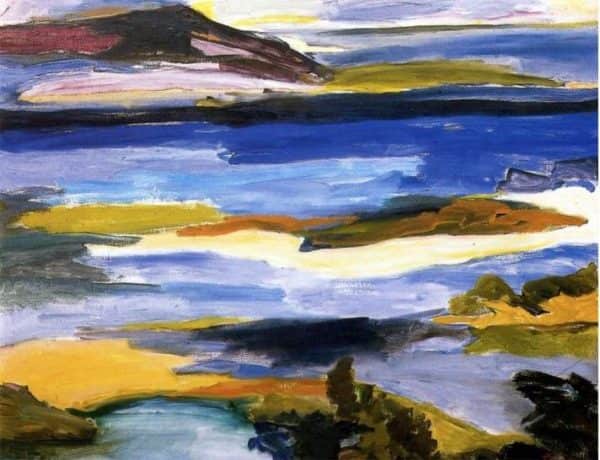
Lina Bryans, “Mallacoota Inlet”, 1964
<> <> <>
IN COMMUNICADO
What a difference between then and now. Today it’s only six or seven hours by car, but on his first visit in 1909 Brady took four days to get to Mallacoota from Sydney: a day and a half by steamer to Eden; all next day by coach to Genoa, and most of the next by rowboat to Captain Stevenson’s Point.
“They rowed us slowly down the beautiful Genoa River. A fair wind was blowing as the boat entered the broadwater. Virgin forests fringed its indented shores and mantled the low-lying hills that encircled it.
We crossed this quiet sheet of water, entered the narrows, sailed through a mile-long rent in the forested hills and broke out into a wider inlet dotted with little seaward islets. Eastward it was fringed by Howe Ranges; Northward it lost itself in a maze of woodland havens, jungled creeks. and hidden bays.”5
Communications then were no better than the transport; mail took just as long, and although the telephone had arrived at Mallacoota West, few people had a phone. As Henry Lawson wrote:
It is one long ring for Kiah; it is two rings for Green Cape;
It is three for Gabo Island; and to have it all ship shape,
One for Eden. Four rings quicken Mallacoota’s interest;
And a long ring and a short one gives you Mallacoota West.6
Contrast today’s smartphones and Facebook, Twitter and Instagram giving instantaneous visual access to a worldwide circle of Friends.
How times change.
Inlet inspired, the
OMG texts echo. A-
cronymic mantra.
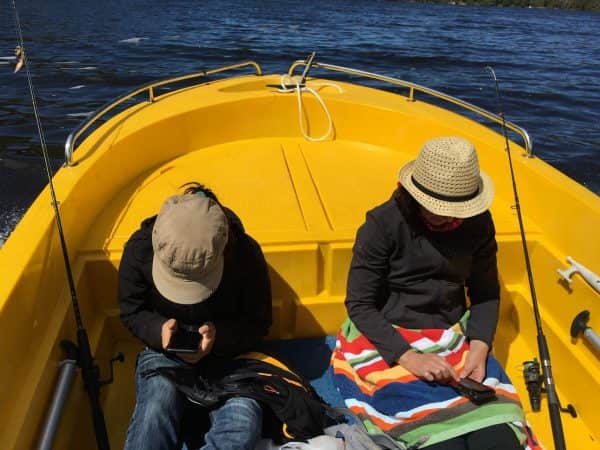
“They rowed us slowly down the beautiful Genoa River,” E.J. Brady, 1909
<> <> <>
AM BASTEIR
It was the “far Cuillins”, a splendid mountain range on the Isle of Skye, that were “pullin’ away” the singer (and many a rock climber) in the Scottish ballad “The Road to the Isles.”
The Cuillins cast the same spell and weave the same magic as does Mallacoota. Both, in the words of the song, “are puttin’ love on me.”
Am Basteir (“The Executioner”) is the Celtic name given to one of the Cuillins’ more forbidding peaks. A craggy spine of black gabbro rock, Am Basteir challenges the fainthearted as it looms on the skyline beside its prominent sentinel Tooth.
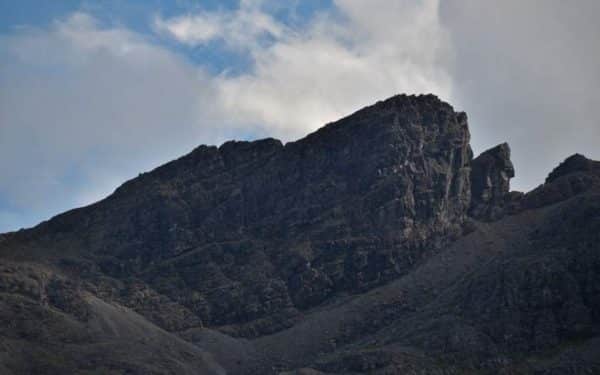
Am Basteir and tooth
It brings to mind the dark rock stack disappearing into the sea at the very tip of Bastion Point – it too with jagged ‘tooth’ close at hand. From here you look east to Cape Howe – the tooth pointing to Tullaberga Island on which the Monumental City wrecked in 1853 just half a kilometre offshore from where the Riverina was to beach 70 years later – and west to Shipwreck Creek where the old slaver Schah came to grief in 1838.
This coast by Bastion – also an executioner!
Howe to Shipwreck? Creak
Keels on coast cantankerous.
Bastion tooth bites.
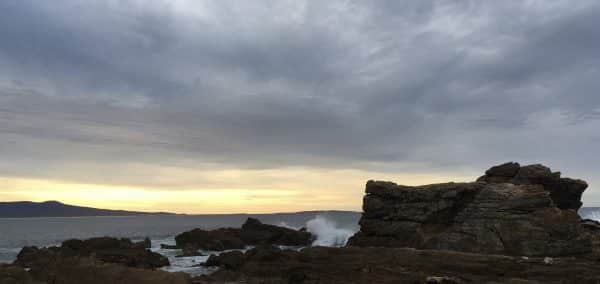
Bastion Point
<> <> <>
TALES YOU LOSE
Giorgio de Chirico painted The Disquieting Muses in 1918. A landmark of modern art, its metaphysical mystique still intrigues today.

Giorgio de Chirico, “The Disquieting Muses”, 1918
It became a cash cow for the artist, earning him ready income when he repainted it time and again. Fifty years later he even made sculptings of it. All this perhaps in response to his latter day critics, or perhaps it was nothing more than sharp business practice.
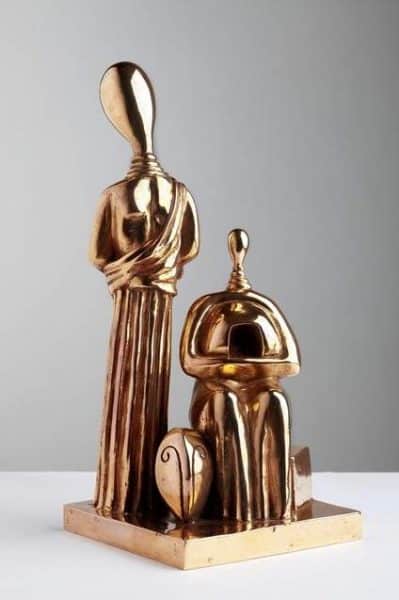
Giorgio de Chirico, “The Disquieting Muses”, 1968
Sharp practice too in “Heads I win, tails you lose”, the con-man’s call that converts the 50-50 chance in a coin toss to certainty – for his pocket.
And so to Mallacoota.
On the breakwater at Bastion Point, a black solitary head-shaped rock, seen best at low tide, brings all this to mind.
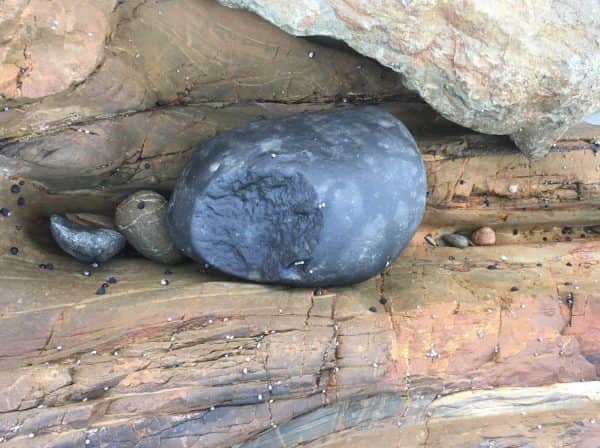
The one certainty in the Bastion debate7 was always going to be a lack of consensus, where heads might well roll.
Heads I win, tails you lose …. perhaps. But the tales you lose – tales not tails – are different. Lost tales are inevitably our lot. Loss is our inheritance. Over the long sweep of time, history is defined by dispossession. All the lost tales – of people, places, names, happenings – all retreating into irrelevance: Carl Rasmus and little Peter, the Schah and the Monumental City.
Impermanence shrouds it all – even the muse’s effaced head and the Bastion breakwater. Both will eventually succumb to the erosion of time, to the vagaries of ocean levels, or perhaps to a long long wave sweeping out of the Tasman to wrap around Howe and Gabo at breakneck speed.
By Bastion, head
Rolls. So transient, this rock
Wall monumental.
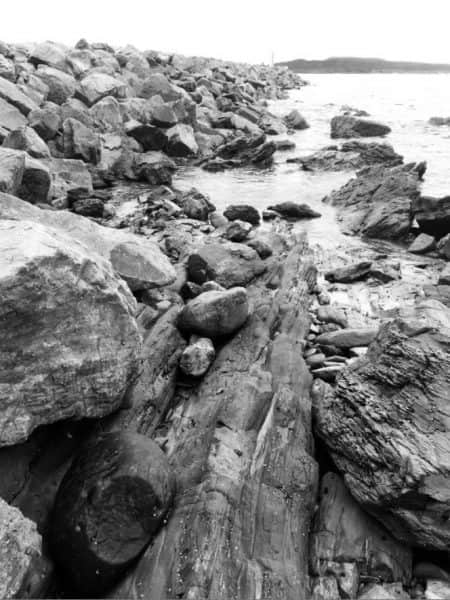
<> <> <>
BULLION
No precious metal excites like gold. You don’t hear of ‘silver fever’ or ‘platinum fever’, but ‘gold fever’ is in the vocabulary, it’s contagious and in years past it infected Mallacoota.
Not too badly though. Reference can be found to a Maxwell’s mine on the eastern shore of the lower lake not far from the Narrows, and there is mention of a Holly reef. Better known, on the far eastern shoreline near the old cemetery, the Spotted Dog mine was worked for four years from 1895 and produced 899 ounces of gold.
That’s less than half the weight of each of the two largest single nuggets found in Australia, indeed in the world: the Welcome nugget found at Ballarat in 1858 and the Welcome Stranger unearthed beneath just one inch of soil near Bendigo in 1869.8
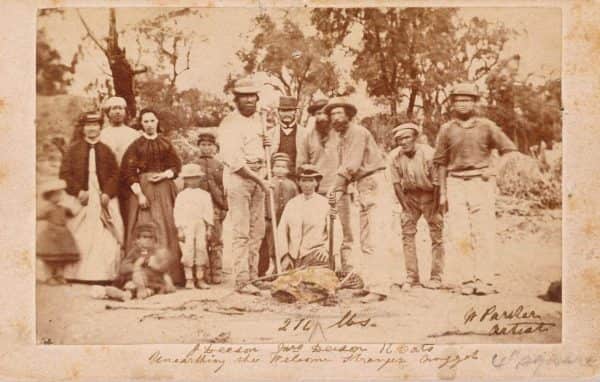
Unearthing the Welcome Stranger nugget
The gold in each nugget would be worth almost $4 million at gold prices today – many times that had the nuggets remained intact. A fortune was lying in wait for some lucky digger.
Thomas Niblock was not a lucky digger. Son of an Oxford and Cambridge qualified Doctor of Divinity, early in 1853 he once again sailed to Australia, this time to make his fortune on the goldfields of Victoria. He first arrived aged 18 in 1838 and found, if nothing else, a wife Matilda.
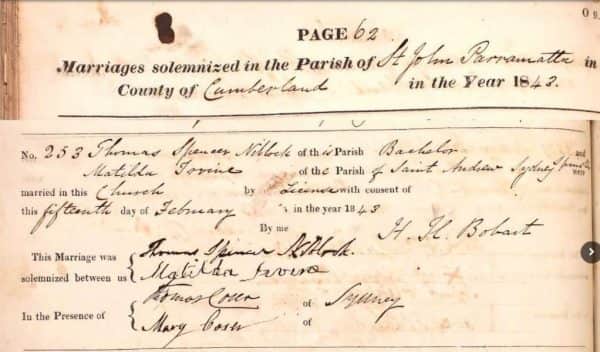
His second visit was of no more material success than the first, than his resettlement to England, or than his failed farming venture to Canada. Leaving wife Matilda, 8 year old son Edward and a newborn infant in Melbourne, Thomas struck out for the Forest Creek diggings at Castlemaine where gold would elude pick and shovel. After but a few short weeks, he returned dispirited and dejected.9
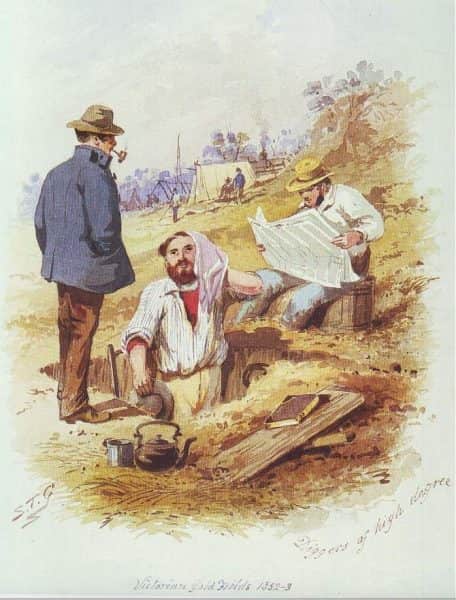
S. T. Gill, “Diggers of high degree: Victorian Gold Fields 1852-3”
He wrote to relatives in England “I have begun to sell my treasures, my long cherished old books,”10 and with the proceeds he found steerage passage for his family on the Monumental City departing Melbourne on Friday 13 May bound for Sydney. The steamer fetched up on the rocks off Tullaberga Island barely 36 hours later.
The bodies of the Niblock family were never recovered. They would not have been weighed down by gold, as was rumoured to be a problem for some other passengers.
There may well have been gold on board. Indeed much gold. Chinese miners returning home and other miners bound for distant parts were said to have been in steerage. To add more grist to the rumour mill, a Board of Enquiry into the wreck heard from one survivor that had evacuation of passengers from ship to shore been better executed, he would not have had to leave his bag of 500 sovereigns behind.11
Talk of a treasure reputedly worth as much as £250,000 persisted. Eventually, in 1919, a syndicate was formed to salvage the wreck. Divers found the strong room but the door was wide open and the strong room empty.12
Yet gold sovereigns have been found at the site.13

1848 Sovereign
An oral history record from 2003 reveals “there’s been times you’ve swum over it and you’ll see a gold coin shining on the bottom and …. you might just happen to see the little knurled edge of a coin ….”14
This speaker, an abalone diver in Mallacoota from the 1960s, linked abalone with gold mining. “It was very similar to the old gold mining days. The price of abalone started to increase and more and more people wanted to get into it and I said, like the old gold miners, if somebody said ‘I found this new reef that’s very rich in abalone’ everybody would go bonkers, and Mallacoota started to kick on pretty good.”15
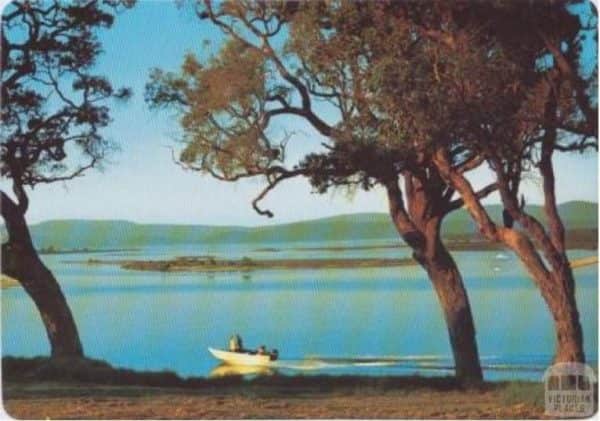
Abalone fishing boat returning to Mallacoota wharf, c 1960s-70s. Murrays Views postcard
Abalone has indeed proved to be Mallacoota’s enduring gold – with replenishable lode still being mined 60 years on.
Such irony! Thomas Niblock and his family drowned in waters rich in latter day gold.
Sovereigns, spotted dogs:
All that glitters, now’s not old –
Abalone’s gold.
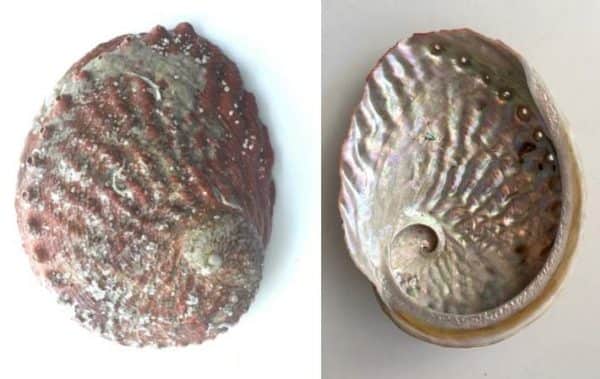
Abalone shell
<> <> <>
MONUMENTAL MUSING
Gabo Island lighthouse and the Washington Monument in Baltimore USA are linked by more than phallic symmetry.
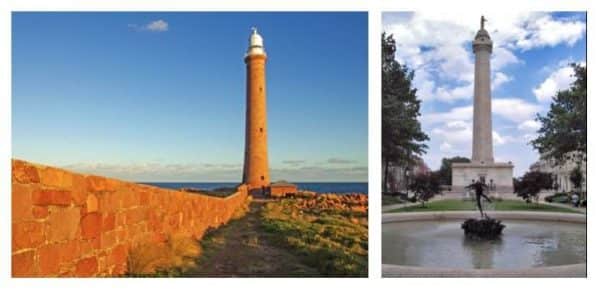
Gabo Island Lighthouse; Washington Monument, Baltimore
Baltimore, the largest city in the state of Maryland, sits at the head of Chesapeake Bay 40 miles north-east of Washington DC. Its monument to George Washington, completed in 1829, was the earliest to honour the first US president.
A connection of sorts between the Washington Monument and Australia, if not Gabo Island, is that the land on which it stands was gifted to Baltimore by John Howard. John Eager Howard that is, famed as a hero of the American Revolution against the British – not John Winston Howard famed as named after British hero Winston Churchill.
Baltimore is said to have more public monuments per capita than any other US city. Called the Monumental City, this sobriquet though is less a tribute to its stone masons than to the resilience and fortitude of its people in times of trouble. In 1827 US president John Quincy Adams called Baltimore a monumental city for this reason, and the term stuck.
However another Adams, Captain William H Adams, is the most tangible link between Gabo and Baltimore. It was he who captained the barque-rigged steamer Monumental City – built in Baltimore in 1850, named after it, and the first steamship to cross the Pacific – when in 1853, with less resilience and fortitude than her namesake city, she was wrecked on rocks off Tullaberga Island with the loss of some three dozen lives.
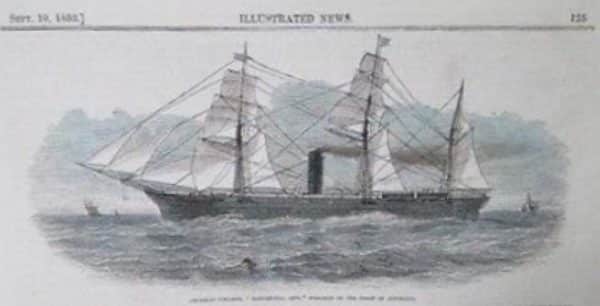
The Monumental City
The tragedy galvanised authorities and a light was built on nearby Gabo Island the following year.

The first Gabo Island Lighthouse
The original wooden structure soon burned down and was replaced in 1860 by the present classical tower constructed from beautiful pink granite mined on the island.
Another link between Gabo and Baltimore is the name Calvert. The 2nd Baron Baltimore, Cecil Calvert, was an absentee landlord par excellence. Appointed in 1632 under Charter of English King Charles I, he became the first Proprietor and Proprietary Governor of the Province of Maryland. Although he lived in Yorkshire, England and never visiting his province, today his statue stands proudly a scant half mile from the Washington Monument.

Cecilius Calvert, 2nd Baron Baltimore
Another Calvert, British born painter and wood engraver Samuel Calvert, lived in Australia from 1848. A few years after the new lighthouse was built, he created a striking image of it, together with a ship not at all unlike the Monumental City passing by in safety. Samuel Calvert’s viewpoint of the Gabo lighthouse would be similar to that of the Cecil Calvert statue looking right to the Washington Monument.
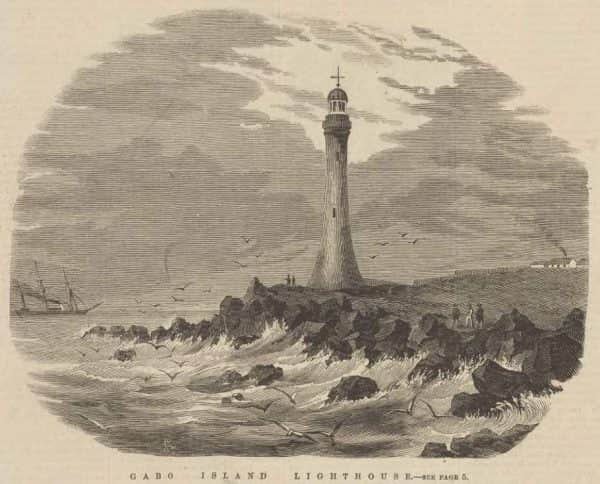
Samuel Calvert, “Gabo Island Lighthouse”, 1863
A favourite son of Baltimore is legendary American baseball hero Babe Ruth. A home run specialist and national inspiration during the Depression years, a team mate said of him “No one hit home runs the way Babe did. They were something special. They were like homing pigeons. The ball would leave the bat, pause briefly, suddenly gain its bearings then take off for the stands.” His home town monument is a given.
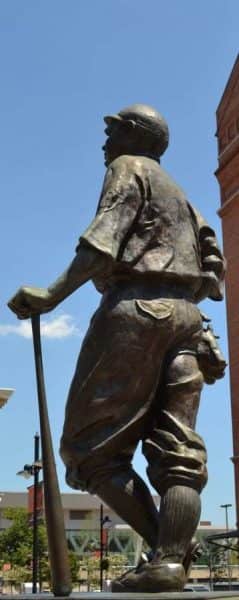
Babe Ruth
Another famed, if somewhat less favoured, Baltimore boy is the curmudgeonly journalist and writer H L Mencken, called the sage of Baltimore, whose acerbic observations remain as relevant today as when written 100 years ago. It’s hard to trump “nobody ever went broke underestimating the intelligence of the American public.” Just ask any presidential billionaire.
Baltimore has no monument to Mencken. When it comes to statues, governors and sports stars beat the literati every time.
Aboard the Monumental City, Captain Adams and his Chief Officer had sailed the Gippsland coast just once – on their way to Melbourne a week earlier – and their charts were not the latest available. As evening approached on 14 May, between them (each blamed the other) they mistakenly thought the approaching headland was Cape Howe, rather than Ram Head 50 kilometres to its west. Each named by Captain Cook, they are not to be confused.
Once abeam Ram Head, the Monumental City changed course and steered NNE towards certain destruction.
It was alleged that Adams and his Chief were warned by passengers who knew the waters that they were too close to land, but sure of their position, they ignored the warnings. They would deny having received them and also deny that the Chief Officer, when earlier bearing off to the East after seeing surf, had said “that’s the way to do it, get into white water and then get out again.”
It all brings to mind another Mencken aphorism: “It is the dull man who is always sure, and the sure man who is always dull.” Deadingly dulled. Sometimes literally.
Every Babe Ruth home run ended with an inevitable veering of the ball towards terra firma. Nothing goes on forever, gravity gets you in the end.
As with life. What’s important is how well we’re positioned when we start to veer.
1853 –
‘Monumental City’ veers
T’wards Tullaberga.
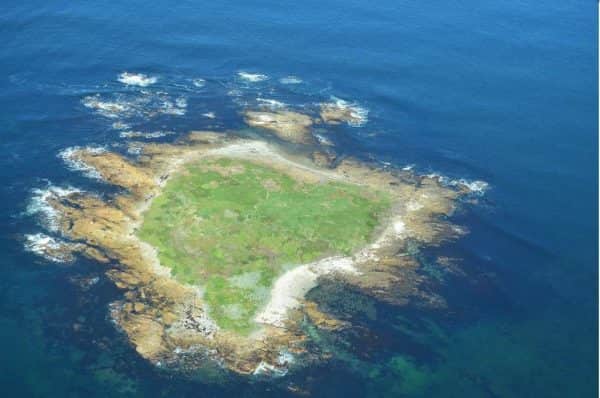
Tullaberga Island looking south. The Monumental City rode up on the rocks over which the sea is breaking seen 50 meters offshore top left.
<> <> <>
MALLEYCOOTA?
Mallacoota’s link to verse is well known courtesy of E. J. (Ted) Brady with his many books of poetry and his writer’s camp up on Captain Stephenson’s Point. Here he hosted versifiers better known than he – notably Henry Lawson and Mary Gilmore.

One poet seldom connected to Mallacoota is Ern Malley. Born in England in 1918, he came to Australia with his mother and sister two years later. He did poorly at school in Sydney and when in 1933 his mother died, he pursued work as a mechanic. He then worked in Melbourne selling insurance policies, repairing watches and doing other work on the side. He returned to Sydney in 1943 and soon passed away from Graves Disease. Malley’s sole book of verse The Darkening Ecliptic was published posthumously the following year.
However his poems, and indeed his life story, were an elaborate hoax concocted by two somewhat traditional poets Harold Stewart and James McAuley. Their intent was to discredit what they saw as pretentious avant-garde poetry, best exemplified in the pages of Angry Penguins, the little magazine edited by Max Harris of Adelaide, John Reed of Heide in Melbourne and Sidney Nolan, who at that time was still serving in the armed forces from which he would soon go AWL. It was to them McAuley and Stewart sent a letter purportedly penned by Ern’s sister Ethel enclosing some of the dead poet’s verses. They had in fact written the poems themselves, drawing on borrowings from past literary giants including Shakespeare, Mallarmé, Purcell, Blake, T.S. Eliot and Keats.
Angry Penguins published all Malley poems, and what is still known as the Ern Malley Hoax burst forth across the Australian litscape. More details of the hoax cab be read on this website: Ern Malley: an introduction and Ern Malley: the Hoax and Beyond. The poems remained a potent presence for Sidney Nolan throughout his life.
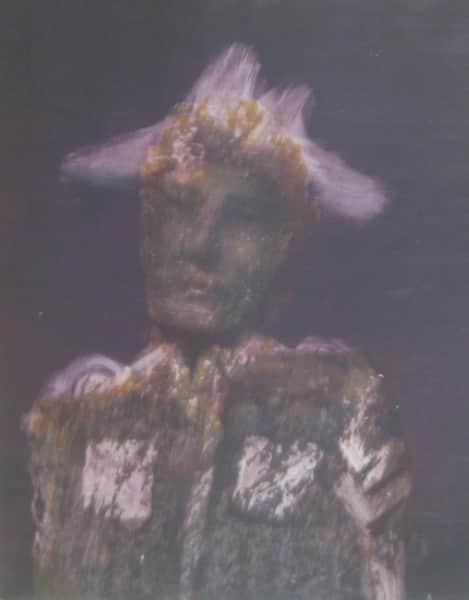
Sidney Nolan, Portrait of Ern Malley, 1969

Sidney Nolan, Ern Malley 1973, Art Gallery of South Australia
The whole affair is still discussed today – including whether the Malley poems were in fact the hoaxers’ best writing? Tonight indeed Adelaide hosts another reprise for the faithful: Ern Malley the poet who never lived … where history and truth collide.
Thus it would seem a main reason why Ern Malley is little known in Mallacoota is because in reality he never existed. Or did he …. just perhaps?
A book Beyond is Anything by one ‘David Malley’ purports to tell the story of a ‘real’ Ern Malley – although Malley was not his real surname – who had a ‘real’ sister Ethel, and who with his ‘real’ wife Lois had a son David who perhaps wrote the book. The story goes that Ern grew up with Jim McAuley and that the poems published in Angry Penguins were actually written by Ern, who left them with Lois during the war asking her to give them to McAuley to get published. The poems were originally called Total Eclipse and the hoaxers changed this to Darkening Ecliptic as well as making a few other changes.
On his way from Sydney to Melbourne, Malley allegedly stayed at Mallacoota with Brady and they formed a friendship. Indeed Brady is said to have inscribed a copy of his book Land of the Sun for Malley on a return visit to Mallacoota to view the total solar eclipse occurring across Victoria in December 1936.
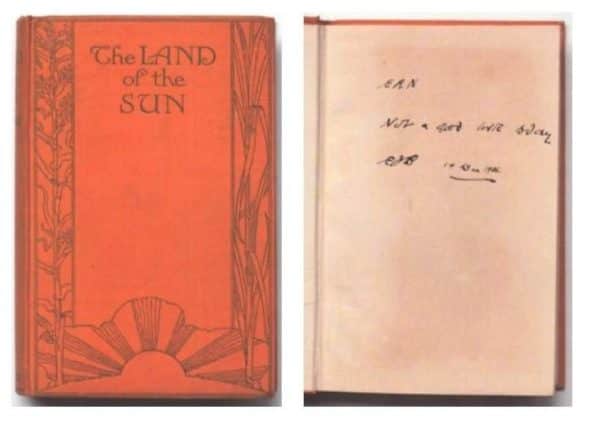
“The Land of the Sun” by E. J. Brady, 1924 and his alleged inscription to Ern Malley: “ERN Not a good title today EJB 14 Dec 1936”
Soon after co-curating the exhibition Ern Malley : the Hoax and Beyond at Heide Museum of Modern Art in Melbourne in 2009, I received a copy of Beyond is Anything in the mail with a letter from David Malley explaining that this was not his real name and that this art of his was perhaps a lie. Be that as it may, a copy is in the National Library of Australia where it is available in the Petherick Reading Room and it can be read on this website: Beyond is Anything.
Perhaps the best known Malley poem is the first, Dürer : Innsbruck, 1495 which Beyond is Anything says was originally called Innsbruck : Mallacoota, 1936 and includes lines such as ” … The colourful spires / And painted roofs, the coast range glimpsed at the back / All reverse in the Mallacoota waters.” Using what has become a well known and quite famous phrase, both versions conclude with reference to a “black swan of trespass on alien waters.”
One of the Malley progenitors was William Blake whose And did those feet in ancient time is best known today as Jerusalem with its familiar musical setting by Hubert Parry. The latter day flag waving, chest thumping and football fevering generated by Jerusalem forgets Blake’s revolutionary intent when writing it 200 years ago. The ‘dark satanic mills’ were real for Blake, as was his vow to not cease from mental fight, nor let sword sleep in his hand: Till he had built Jerusalem, in England’s green & pleasant land. They were also real for Ted Brady whose socialism was evident in his poem The Little Lamp of Lenin and in his work with the Mallacoota Worker’s Cooperative at the time of the Great Depression.
Let this sentiment and a play on Blake’s introductory words be the theme of this musing’s concluding haiku.
And did Ern’s feet …. walk
Upon ‘Coota’s mountains green?
Black swan of Trespass.
<> <> <>
<> <> <>
THE TULLABERGA TIMES
A good name that for a newspaper, The Tullaberga Times. Well …. perhaps a good name for a newspaper once upon a time. Nowadays though, newspapers are just about finished, and apart from that, nothing much has ever been written on Tullaberga Island.
Nothing much has been written about Tullaberga either, but we can be sure very little has been written on, literally on, the island itself – all seven acres of it, little more than a rock with scant vegetation pushing up less than ten metres out of Bass Strait about 500 meters offshore near the south eastern corner of Australia.
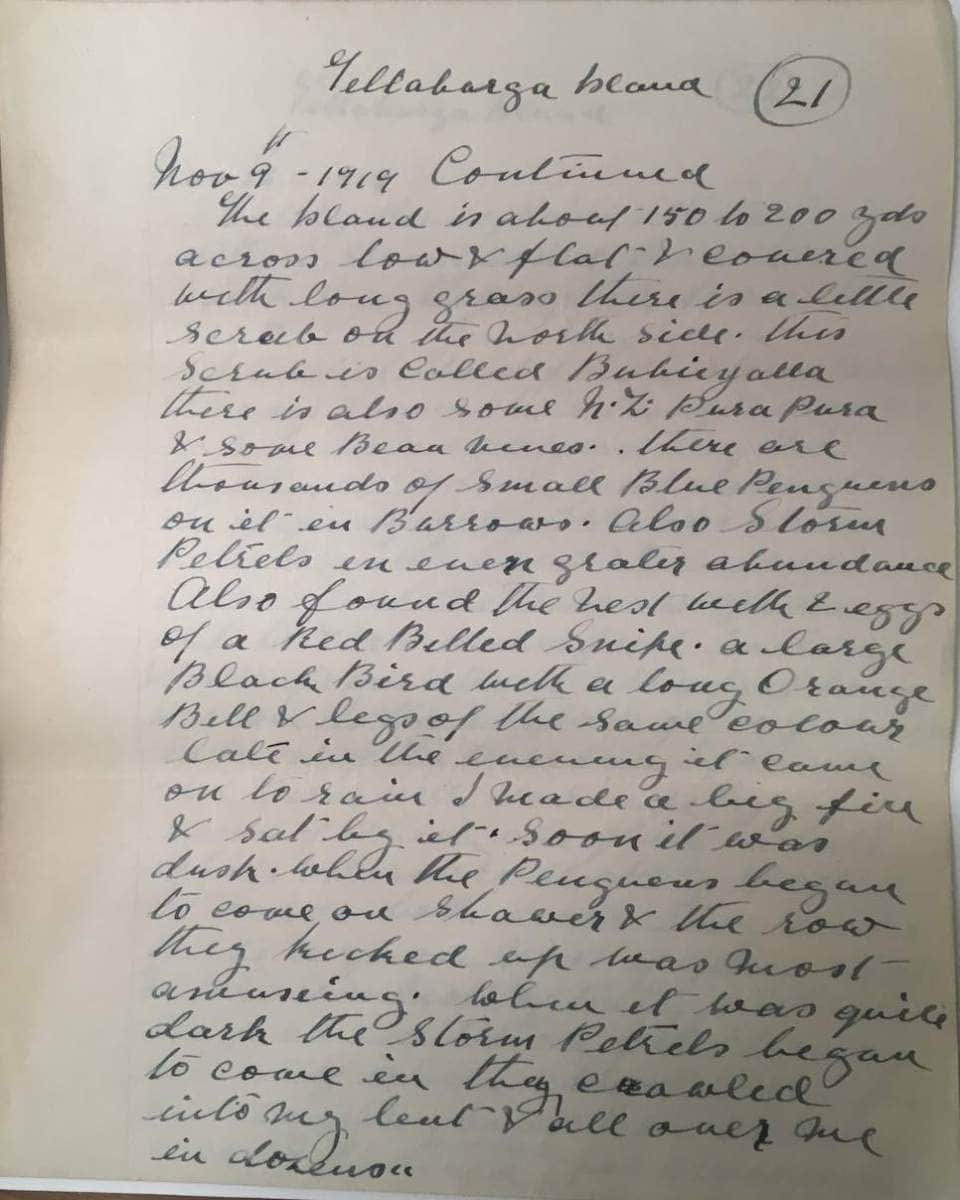
Roy Bell, Collecting notes, 9 November 1919
But above we see a handwritten page actually penned on the island over 100 years ago by naturalist Roy Bell16 who was collecting birds, eggs, shells and molluscs, and visited Tullaberga three times in 1919.
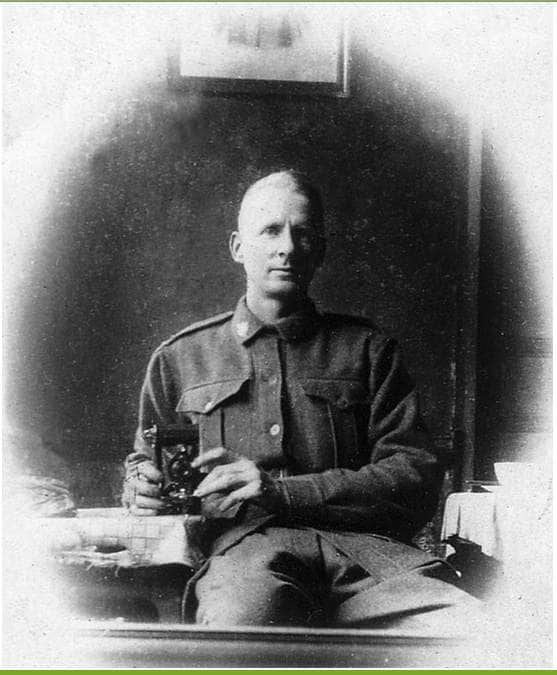
Roy Bell in uniform with his camera
His field notes are transcribed here verbatim. The note dated 9 November 1919 commences “Left Black Head early and rounded Cape Howe.” After unsuccessfully dredging for shells and molluscs near Gabo, “we continued past Gabo Island and landed on Tullaburga Island which is 4 miles south of Gabo Island and 4 miles from Mallacoota. I got my tent ectr up onto the island and made a camp.”
“Late in the evening it came on to rain,” he continues, “I made a big fire and sat by it. Soon it was dusk. When the penguins began to come on shower and the row they kicked up was most amusing. When it was quite dark the Storm Petrels began to come in they crawled into my tent and all over me in dozens.”
The following day his notes notes record “I also went all round the island as soon as the tyde began to make and got a few extra big limpets ectr. I noted on the south side of the island a lot of ships timbers. These I was told came off the Monumental City which was recked the 18 May 1853.”
A few years ago I chanced upon Roy Bells’ collecting notes in the Manuscripts collection at the National Library of Australia. In my researching of Mallacoota’s history I had come across no reference to this illuminating primary source, nor to the poignant and evocative letter from S Charles Johnson, who built Gabo’s wooden lighthouse and held salvage rights to the Monumental City, and who wrote to architect Charles Mapplestone, the designer of the lighthouse still standing today. This letter too is held by NLA along with three letters from Thomas Niblock. Full details of these NLA holdings are provided in the Endnotes, along with the full text of the Johnson letter.
Arising from musings on an imaginary Tullaberga Times, here follow ‘news items’ based on these manuscripts and another based on a comment in the published journal of an East Gippsland sea captain.
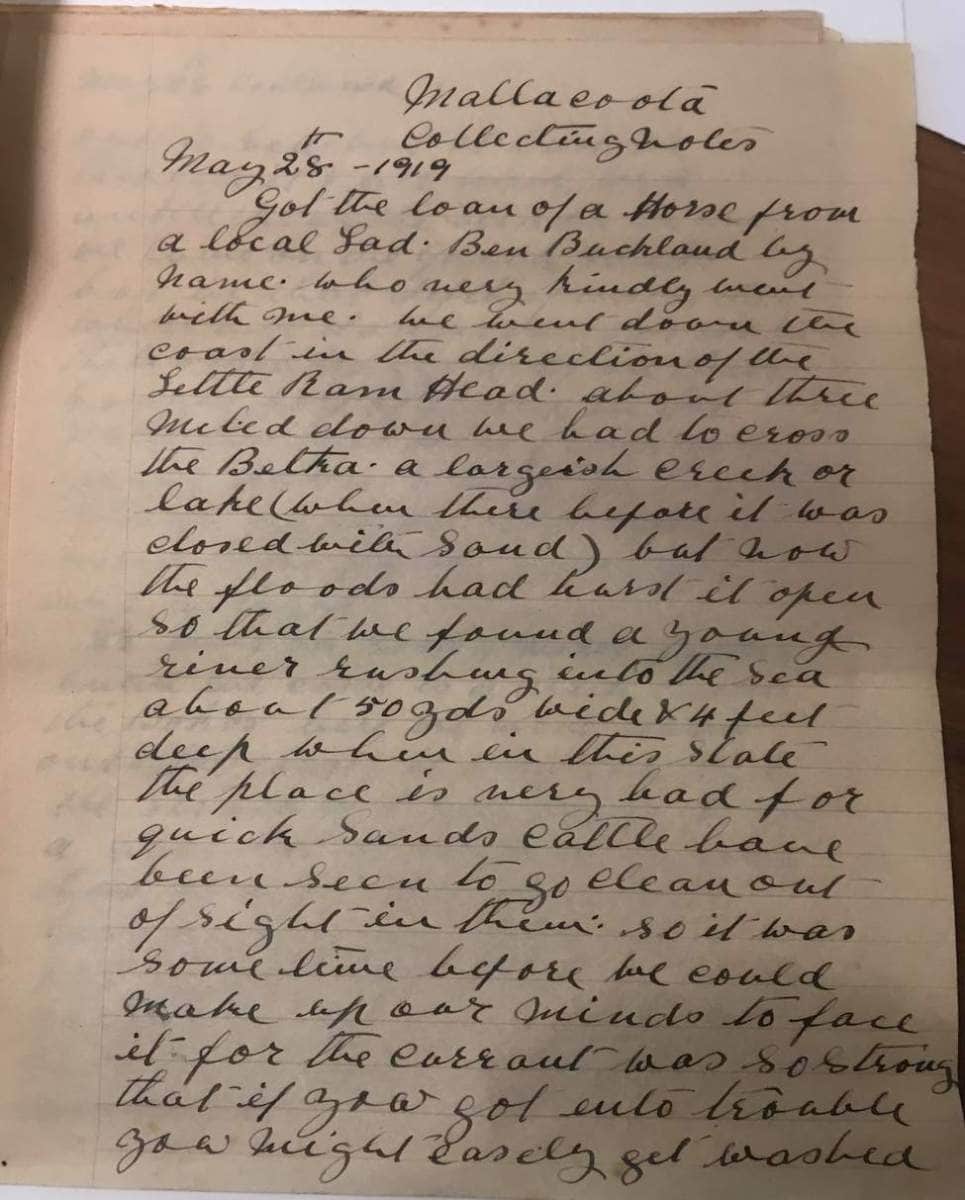
Roy Bell, Collecting notes, 28 May 1919
The above hand-written page, dated May 28, details Roy Bell’s crossing of the Betka River on a collecting trip to Shipwreck Creek.
An imaginary Tullaberga Times from 1919 could well have run his story thus:
QUICK SANDS AT BETKA
“Our correspondent Mr Roy Bell, recently arrived from service in France, has visited Mallacoota and reports having got the loan a horse from a local lad, Ben Buckley by name, who very kindly went with him. They went down the coast in the direction of Ram Head and about three mile down had to cross the Betka, which he describes as a largish creek or lake. When there before it was closed with sand, but now the floods had burst it open so that they found a young river rushing into the sea about 50 yards wide and 4 feet deep.
When in this state the place is very bad for quick sands and cattle have been seen to go clean out of sight in them. So it was some time before they could make up their minds to face it for the currant was so strong that if they got into trouble they might easily get washed out sea.
At last they tackled it and all went well until near the middle when they came on the quick sands but in that depth of water they were not dangerous for when the horses bogged down their bodies sort of floted in the water. This kept then from going right down and they floundered thrugh. Near the other side the sand was firm so they got out alright.
Mr Hill also reported that closer to home on Tullaberga, he had noted a lot of ships timbers on the south side of the island which had come off the Monumental City. Readers are reminded of an 1857 edition of this newspaper which included a most poignant account from a Melbourne correspondent under the header Timbers on Tullaberga.”
Readers of these musings may recall mention of Thomas Niblock who with his wife and two children perished with the Monumental City. Four years after the tragedy, Niblock’s brother-in-law sought further information and wrote to an acquaintance of his who had migrated to Australia.17 His acquaintance was the architect Charles Mapplestone who was indeed well placed to help, having been charged with designing the new lighthouse on Gabo Island.
Mapplestone in turn wrote to S Charles Johnson who, uniquely able to give a most detailed account, replied at some length. Johnstone’s poignant and evocative account18 was sent to Niblock’s family and the following images are the first and last pages of his 4 page handwritten letter.
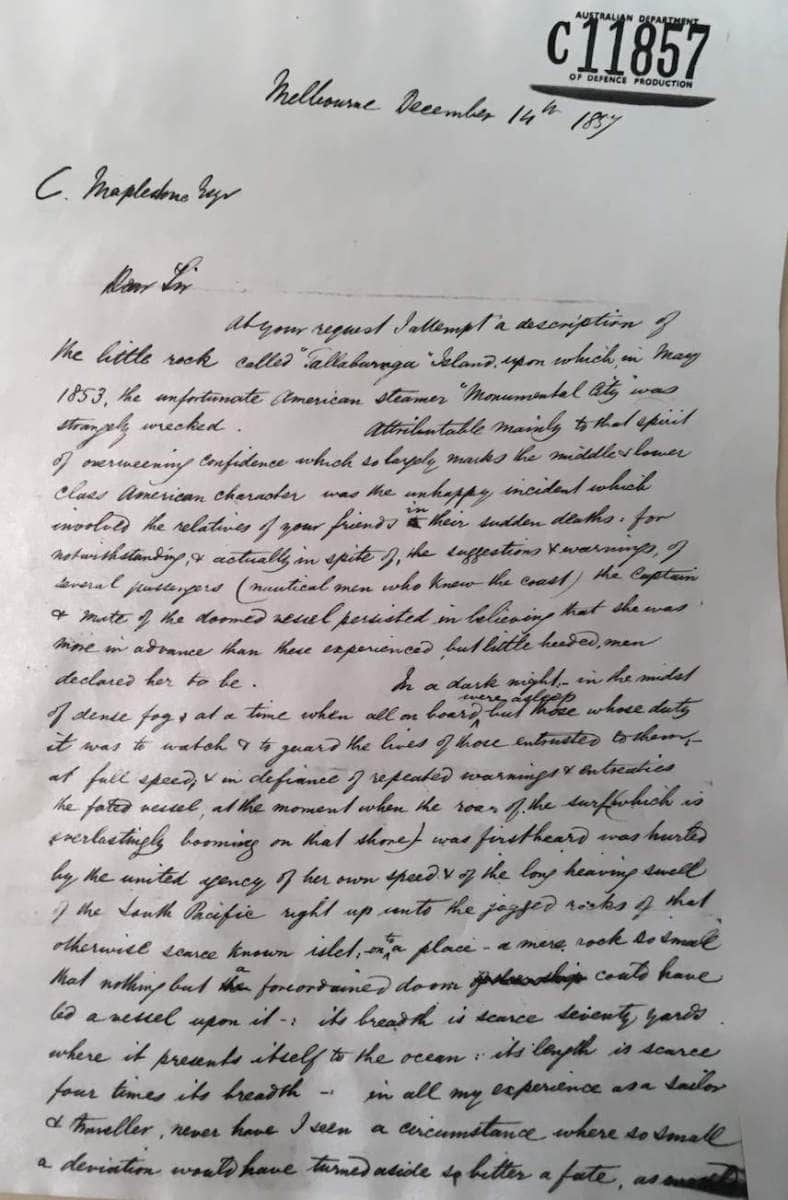
S Charles Johnson, letter to Charles Mapplestone, 14 December 1857, first page
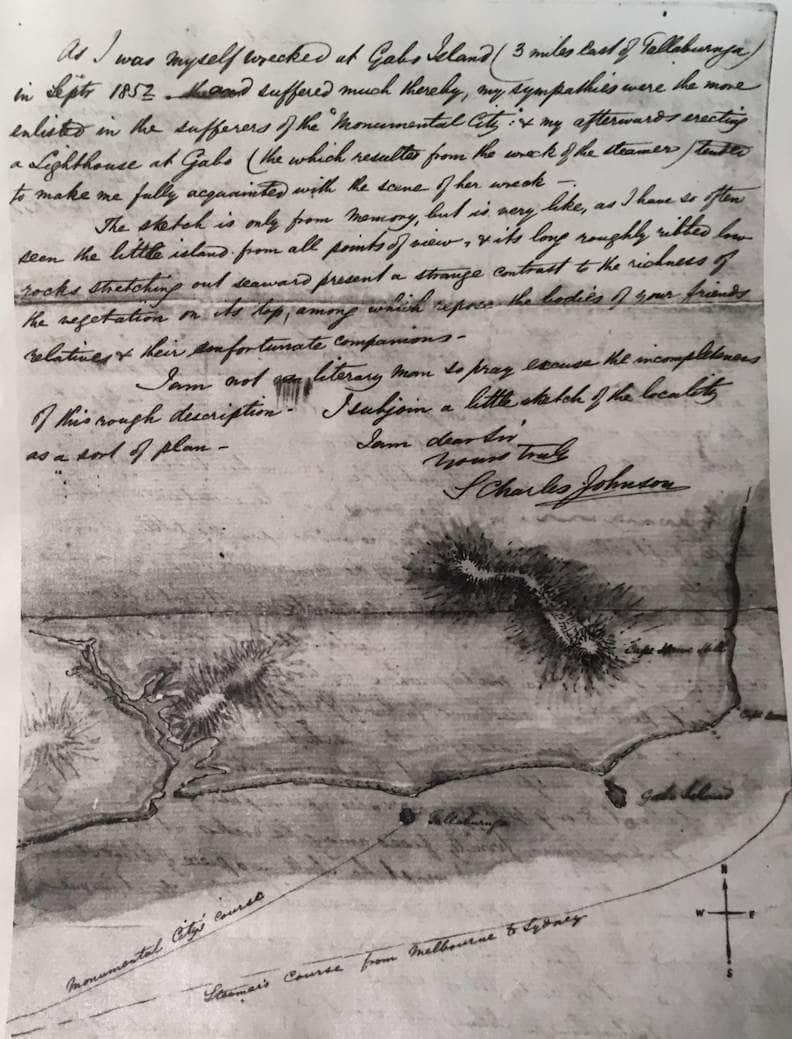
S Charles Johnson, letter to Charles Mapplestone, 14 December 1857, last page
An 1857 issue of the Tullaberga Times of our imagination, with Johnson as correspondent, may well have appeared thus:
TIMBERS ON TULLABERGA
“Our Melbourne correspondent, Mr S Charles Johnson, himself wrecked at Gabo Island in Septr 1852 and suffering much thereby with sympathies the more enlisted in the sufferers of the “Monumental City”, afterwards erecting a lighthouse at Gabo and is fully acquainted with the scene of her wreck.
In reply to a letter seeking information about Thomas Niblock, one of the victims, Mr Johnson has described the site of the wreck in the four intervening years. The captain and his crew were saved; some few of the passengers too, but among the green bushes and luxuriant grass that covers the island’s top there now lie buried six and twenty poor souls, whose terrible and sudden death has left many an aching heart in old England.
The Sydney Government caused all the bodies to be collected and buried. – at the head and foot of each grave is placed a piece of white painted board (once portions of the cabin fittings of the vessel.)
These grave-marks can be seen from the sea by those whose pursuits take them near to the island. – and in their solitude little spot, they seem like a record and a protest against that ungodly self esteem and vanity of the one or two men at whose doors the terrible end of their occupants can and will be laid.
Some three years after the wreck, Mr Johnson became the owner of it, and in the course of an inspection of it, happened upon the skull of a little child of about 8 or 9 years of age, and also upon a pair of child’s shoes of corresponding size – firmly fixed among the rocks at low water – with sad and pious care he wrapt the skull in a piece of bloodstained cotton canvas – which he had picked up on the beach – and deposited it in one of the graves. God only knows, he says, the child of the family enquiring may have received this act of duty from him.
‘I have so often seen the little island from all points of view,’ our correspondent concludes, ‘and its long roughly ribbed low rocks stretching out seaward present a strange contrast to the richness of the vegetation on its top, among which repose the bodies of your friends’ relatives and their unfortunate companions.’ “
An update on the Tullaberga graves, published midway between the two above, may have appeared as follows in a May 1882 issue of our hypothetical Tullaberga Times.
GRUESOME FIND A GRIM REMINDER
“Our Bairnsdale correspondent, Captain James Bull of Paynesville, reports from Gabo Island (where his schooner the Magnolia is anchored pending salvage operations on the iron barque Romeo that ran ashore in fog near Ram Head on 14 February last when bound for Sydney from Hamburg). The following is an extract from Captain Bull’s journal.19
‘On the days we did not leave the anchorage, if there was nothing to do about the schooner on her gear and sails, we would go fishing or take the boat and pull three miles over to Tullaberga Island to shoot some rabbits. … The only places in East Gippsland where rabbits were to be found were Tullaberga Island, and another small island called Rabbit Island near the entrance to Corner Inlet.
The first time we went over to Tullaberga we picked up several skulls and other human bones. They were the remains of some of the people who lost their lives when the schooner Monumental City was wrecked there some 30 years before. They had been buried on the island by the survivors, but they had been buried too close to the beach, with the result that the erosion of the sea in some recent storm had washed them out. We gathered all we could find and carried them further inland. The next time we came on shore we brought a shovel and buried them again.’ ”
Whilst The Tullaberga Times may only have gone to print in our imaginations, the facts behind these stories, the people who wrote them and the ink and paper of their writing are very real.
Inked pages herald
Full fathomed loss. A dreaming
On Tullaberga
Let the stark reality of the actual writings conclude this musing by reinforcing a realisation that there was nothing hypothetical about Tullaberga that morning of 15 May 1853 for the three dozen lost souls who did not survive it.
Thirty white panels
Stand mute in the sand. Tribute
On Tullaberga
END NOTES
- E. J. Brady, “Cinderella,” in L. Rubinstein and E. J. Brady, Dreams and Realities, York Press, Melbourne, 1944, p. 124.
- ibid., p. 121.
- ibid.
- Matsuo Bashō (1644-1694) is one of Japan’s best known Haiku writers.
- E. J. Brady, “Cinderella,”op. cit., p. 121.
- Henry Lawson, Mallacoota West, A song of the telephone, 1910.
- Controversy raged as to whether a breakwater/boat ramp/car park complex should be built at the point. A flavour of the passions aroused can be found in these links: Save Bastion Point, Ministerial assessment and Endangered waves. The breakwater was completed a few years ago. A sign now warns of the danger caused by shifting sands which varyingly silt the exit from the new harbour – the sign says the facility should only be used by experienced boat handlers familiar with local conditions.
- For contemporary accounts of the discovery of the Welcome Stranger nugget, see http://members.westnet.com.au/likelyprospects/welcome_stranger_nugget.html.
- David A. Gerber, “Thomas Spencer Niblock: A Dialogue of Respectability and Failure,” in Authors of Their Lives: The Personal Correspondence of British Immigrants to North America in the Nineteenth Century, New York University Press, New York, 2006, p. 230.
- Thomas Spencer Niblock to Edward Thomas Spencer, Melbourne, April 15, 1853, Letters of Thomas Spencer Niblock, MS 396, National Library of Australia.
- Sydney Morning Herald, June 13, 1853, p. 6. First class passenger Gavin McKerrow vented his spleen to the Commissioners in no uncertain terms. As reported in the Herald: “Here some warm words took place between Mr. McKerrow and Captain Adams – the former persisting in asserting that a line might easily have been taken across, and declaring that, could he have found a bag of his, containing 500 sovereigns, he could easily have saved it. The Chairman, however, requested that this altercation might cease, as it was imperative that the inquiry should be conducted with the strictest impartiality, and that temper should be kept on the part of the witnesses.”
- See http://marinelife.org.au/?page_id=543 and The Evening Star, Dunedin, Sep 6, 1919, p. 1, and also http://oceans1.customer.netspace.net.au/gabo-wrecks.html.
- Mark Staniforth, SS Monumental City, First Steamship to cross the Pacific, Victorian Archaeological Survey Occasional Report Series, Number 24, Ministry for Planning & Environment, Melbourne, April 1986, p. 7. Available online at https://ehlt.flinders.edu.au/archaeology/department/publications/staniforth/1986a.pdf.
- John Black, Tales from the Deep, Oral history, 2003, see http://www.cv.vic.gov.au/stories/built-environment/tales-from-the-deep/gold-rush-diving-on-the-monumental-city/.
- John Black, op. cit., see http://www.cv.vic.gov.au/stories/built-environment/tales-from-the-deep/john-black-oral-history-part-2/.
- For a brief biography of Roy Bell and outline of these field notes see Papers of Roy Bell, MS 9624, National Library of Australia.
- See Letters of Thomas Niblock, MS 396, National Library of Australia.
- The following transcription was made by the author.
Melbourne
December 14th, 1857
C. Maplestone Esq
Dear Sir
At your request I attempt a description of the little rock called “Tullaburnga” Island upon which in May 1853, the unfortunate American steamer “Monumental City” was strangely wrecked.
Attributable mainly to that spirit of overweening confidence which so largely marks the middle and lower class American character was the unhappy incident which involved the relatives of your friends in their sudden deaths, for notwithstanding, and actually in spite of, the suggestions and warnings of several passengers (nautical men who knew the coast), the Captain and mate of the doomed vessel persisted in believing that she was more in advance than these experienced, but little heeded, men declared her to be.
In a dark night – in the midst of dense fog and at a time when all on board were asleep but those whose duty it was to watch and to guard the lives of those entrusted to them – at full speed, and in defiance of repeated warnings and entreaties, the fated vessel, at the moment when the roar of the surf (which is everlastingly booming on that shore) was first heard, was hurtled by the united agency of her own speed and of the long heaving swell of the South Pacific right up onto the jagged rocks of that otherwise scarce known islet, on to a place – a mere rock so small that nothing but a foreordained doom could have led a vessel upon it -: Its breadth is scarce seventy yards where it presents itself to the ocean: its length is scarce four times its breadth. In all my experience as a sailor and traveller, never have I seen a circumstance where so small a deviation would have turned aside so bitter a fate, as would have resulted had the “Monumental City” been only 50 yards either right or left of the island the minute before she struck.
In few instances of my experience of sea matters have I ever seen or heard such pitiable proofs of the life enduring sadness which may be caused by a moments hesitation or obstinacy – One half minute, when first the ears of the careless watchers were startled by the warning sound of the breakers, would have saved all – . Those fated seconds were passed in fearful listening for the assurance that the previously sounded warnings might be true.
That all might have been saved was proved that all the crew was saved. The Captain, Adams, was among the first to leave his vessel and his more precious passengers – ! The surgeon – noble fellow – in attempting to save some ladies perished by lingering too long for his own life, but not too long for the exemplification that nobility of soul still remains in the midst of civilisation.
The captain and his crew were saved; some few of the passengers too, but among the green bushes and luxuriant grass that covers the island’s top there now lie buried six and twenty poor souls, whose terrible and sudden death has left many an aching heart in old England.
The Sydney Government caused all the bodies to be collected and buried. – at the head and foot of each grave is placed a piece of white painted board (once portions of the cabin fittings of the vessel.)
These grave-marks can be seen from the sea by those whose pursuits take them near to the island. – and in their solitude little spot, they seem like a record and a protest against that ungodly self esteem and vanity of the one or two men at whose doors the terrible end of their occupants can and will be laid –
At scarce a mile from the shore, upon which for miles there is not a particle of rock or stone to be seen and nothing but sand, there suddenly presents itself this rocky island of Tullaburnga. Lying low – in fine weather – it may escape observation entirely, and in fact very few persons know of its existence, as it is 6 or 8 miles within the usual track of vessels. But in the storm, the long roll of the sea dashes in upon it with a fearful velocity and power – such as I have never seen exceeded or scarce equalled anywhere, and at such times the spray and foam are tossed to a fearful height on the long low reef where the ribs of the vessel now are. The steamer ran on shore in a calm and at high water, and for a few hours (until daylight) the calm continued; then (as is very frequent in that locality) a sudden storm arose. No preparation had been made for landing – the previous confident boastfulness of the officers had been followed by a correspondingly opposite feeling of cowardly hesitation – and instinctively a brave fellow, a sailor called Charles Plummer – swam on shore with a rope at imminent risk and by its means those who were saved got on shore. The poor children and their mothers, the men who remained to attempt to save the helpless ones, were all dashed to pieces along with the fated ship. The rollers came in twenty feet high and crashed the strong vessel in twain.
Next day six and twenty out of the 33 wrecked bodies were recovered. No names could be ascertained; the surge had kept them floating and dashing around on the little island, strangely enough to tell. Some of the crew made temporary graves for the unfortunates. The crew constructed a raft and got to the mainland and eventually to Sydney.
Captain Adams received the merited excoriations of a public meeting where he had the hardihood to appear to solicit pecuniary assistance for himself and his ruined crew!
I, some three years after the wreck, became the owner of it, and in the course of an inspection of it, happened upon the skull of a little child of about 8 or 9 years of age, and also upon a pair of child’s shoes of corresponding size – firmly fixed among the rocks at low water – with sad and pious care I wrapt the skull in a piece of bloodstained cotton canvas – which I picked up on the beach – and deposited it in one of the graves. God only knows, the child of your friends may have received this act of duty from me.
“Tullabunga” Island lies about 8 miles westward of Cape Howe, and the cause of the wreck was the belief of Captain Adams that his vessel had gone faster than she had and that she was round Cape Howe, and he in this obstinate belief (as against all urgent representations and remonstrances of some of his passengers) altered the course of the vessel too soon so as to make her steer nearly north, which is the course after passing the “Howe” in going from Melbourne to Sydney –
As I was myself wrecked at Gabo Island (3 miles east of Tullaburnga) in Septr 1852 and suffered much thereby, my sympathies were the more enlisted in the sufferers of the “Monumental City”, and my afterwards erecting a lighthouse at Gabo (the which resulted from the wreck of the steamer) tended to make me fully acquainted with the scene of her wreck.
The sketch is only from memory, but is very like, as I have so often seen the little island from all points of view, and its long roughly ribbed low rocks stretching out seaward present a strange contrast to the richness of the vegetation on its top, among which repose the bodies of your friends’ relatives and their unfortunate companions.
I am not a literary man so pray excuse the incompleteness of this rough description. I subjoin a little sketch of the locality as a sort of plan –
I am dear Sir
Yours truly
S Charles Johnson
.
- Journal of Captain James Bull, in Small ships and adze chips, J.C Bull, published by author, Metung, Victoria, 1978, p. 115.
One Comment
Join the conversation and post a comment.


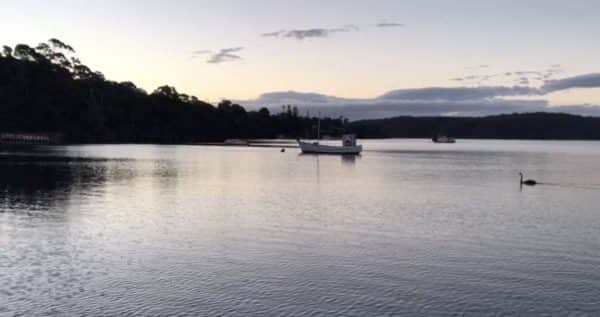
Hi David
I’ve never been to Mallacoota, but thanks to you I’ve been engrossed in it all morning.
I was looking at Disquieting muses again only last night, and with you find it intriguing; disquieting in itself, and memorable for that.
I very much like the photo in your post of the couple in the boat, looking not at “the beautiful Genoa River,” but at things hand-held, and your very sly and not at all unkind caption.
Altogether a wonderful beginning to the day, and to the week.
Warmest regards
Roy